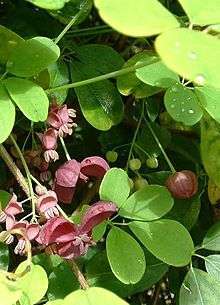Akebia
| Akebia | |
|---|---|
 | |
| Akebia quinata | |
| Scientific classification | |
| Kingdom: | Plantae |
| (unranked): | Angiosperms |
| (unranked): | Eudicots |
| Order: | Ranunculales |
| Family: | Lardizabalaceae |
| Genus: | Akebia Decne. |
| Species | |
|
See text. | |
Akebia is a genus of five species of flowering plant, within the family Lardizabalaceae. The scientific name, akebia, is a Latinization of the Japanese name for species Akebia quinata: akebi (通草).
Species
There are five species including:[1]
- Akebia chingshuiensis T. Shimizu, native to Taiwan
- Akebia longeracemosa Matsumura, native to China and Taiwan
- Akebia quinata (Houttuyn) Decaisne – Chocolate Vine or Five-leaf Akebia, native to China, Korea and Japan
- Akebia trifoliata (Thunberg) Koidzumi – Three-leaf Akebia, native to China, Korea and Japan
- Akebia trifoliata subsp. australis (Diels) T. Shimizu
- Akebia trifoliata subsp. longisepala H. N. Qin
- Akebia trifoliata subsp. trifoliata
Invasive plant
Akebia quinata is listed under the National Pest Plant Accord as an "unwanted organism" in New Zealand since it is considered to be an invasive plant.[2] It is also considered invasive in several states in the eastern United States, according to the Plant Conservation Alliance.
Akebia in Japan
Akebia is often mentioned in Japanese literature, where it is evocative of pastoral settings.[3] Although the akebi commonly refers to the five-leafed species, the three-leafed species is used in much the same way for novelty food, medicine, and for vine material.
It is something of minor food source that was foraged in the past when other more conventional food sources were scarce. The pods contain a white, semi-translucent gelatinous pulp that is mildly sweet and full of seeds.[4] The taste is described as sweet but rather "insipid".[4] Some people recollect in idyllic terms how they foraged for it in the hills as children.[5]
The purple-colored, slightly bitter rind has been used as vegetable in Yamagata Prefecture[5][6] or in those northern areas, where the typical recipe calls for stuffing the rind with minced chicken (or pork) flavored with miso.[6] Minor quantities of akebia are shipped to the urban market as novelty vegetable.
In Japan, the leaves are made into a tea infusion.[3] Also, Akebia vines are used for basket-weaving crafts. An old source lists Minakuchi, Shiga and Tsugaru (now Aomori Prefecture) as localities that produced baskets from the vines of trifoliate variety.[7]
Gallery
-

Akebia quinata leaves and flowers
-
Female flowers of Akebia Mitsuba (large) and male (small)
-

Mitsuba early fruit of Akebia
-

Akebia flower
-

Early fruit of Akebia
References
- ↑ "Akebia". Flora of China. Retrieved 2009-04-05.
- ↑ "Akebia". Biosecurity New Zealand. Archived from the original on 1 December 2008. Retrieved 2009-01-13.
- 1 2 Davidson, Alan, and Tom Jaine. The Oxford companion to food. Oxford University Press, USA, 2006. 805. Print. Retrieved Aug. 09, 2010, from
- 1 2 Sargent, Charles Sprague (March 25, 1891), "Plant Notes-The Fruit of Akebia quinata (With Figure.)" (google), Garden and Forest, 4 (161): 136
- 1 2 Nimura, Kazuo(二村一夫)r (2006-07-22). "食の自分史 (Self-history on food)". 『食の自分史』. Retrieved April 2012. Check date values in:
|access-date=(help) - 1 2 Yamagata City Health Center (2011-01-31). "あけびの詰め物 (stuffed akebia)". Retrieved April 2012. Check date values in:
|access-date=(help), photograph shows trifoliate variety (twig, fresh purple plant, and prepared dish) - ↑ Agricultural Society of Japan; Dai Nihon Nōkai(author alia) (1895). Useful plants of Japan: described and illustrated (google). 1. Agricultural Society of Japan. p. 92.
Further reading
- Bailey, L. H. (2005). Manual of Gardening (Second Edition). Project Gutenberg Literary Archive Foundation.
External links
- Akebia: Three Varieties including photographs by Paghat's Garden
- Akebia: Edible Fruits including photographs by Paghat's Garden